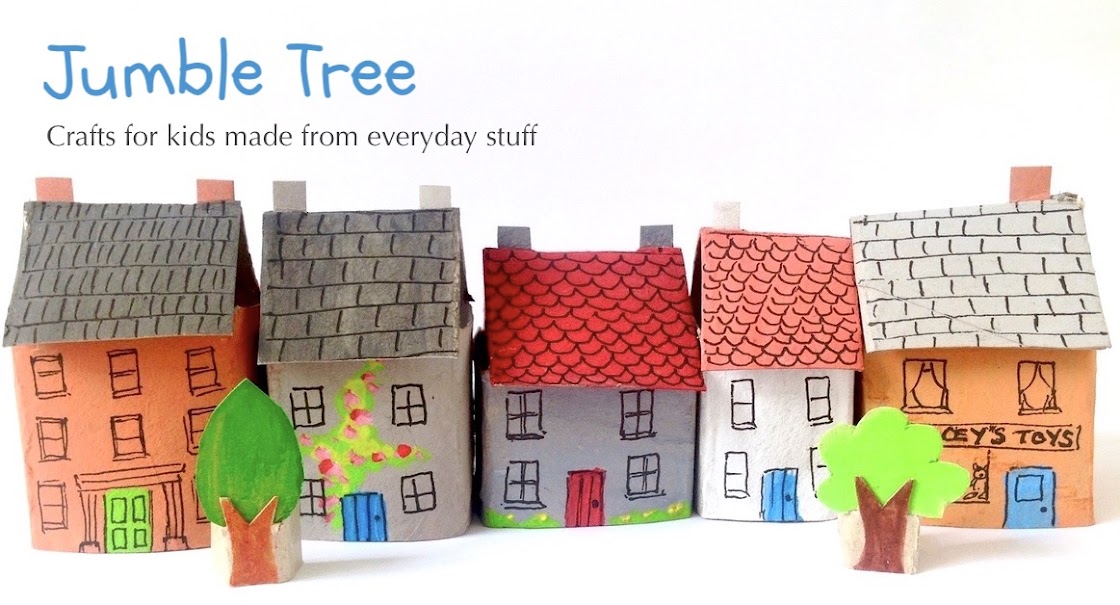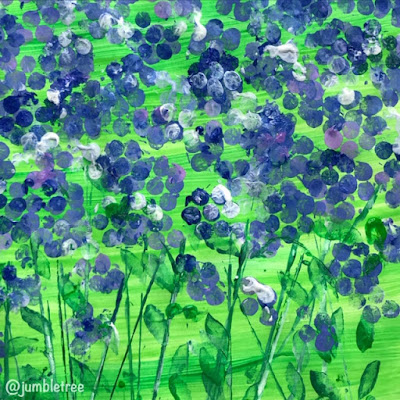You will need:
Toilet paper tube (not too narrow. Ours had a diameter of about 5cm/2in.)
Pencil
Ruler
Paint
Green paper (or plain painted)
Black marker pen
Strip of cereal box card (3cmx16cm/1inx6in)
Kitchen paper roll
Nail scissors or similar (to be used by adult)
1. Apart from the green wings, all the woodpecker pieces come from the TP roll. Flatten the tube with you hand on a table or other surface, and press firmly along the creases.
With a pencil, roughy mark the middle at one end, and use a ruler or something straight to draw a line down the centre.
2. To help get the shape of the body, draw a line across the tube, roughly about 2cm from the top.
Now, start the curve of the head at the top edge, halfway between the vertical pencil line and the side of the tube (I've marked it with a short line in the photo below). Aim for where the pencil lines cross. Then curve the rest of the body downwards, towards the bottom corner.
Cut it out, carefully cutting along the line. This is the body shape.
We're now going to work on what's left of the tube, to make the tail feathers, head plume and beak.
I've kept them beside the body piece, so it's hopefully easier to see where they come from.
3. The tail feathers come from the top of the leftover piece, where you cut out the head. Keeping any pointy bits, cut diagonally across to the fold at a sharpish angle. So you end up with a narrow, pointy triangle.
4. The head plume comes from the bottom part. Simply cut along the pencil line.
You don't need double thick card, so only keep one of the pieces, and cut straight across it, about 3cm/1in from the edge. See the photo below.
5. At the very top of the body piece (on the RHS of the picture below), snip across the card diagonally, at a sharp angle, from where the curve for the head starts (the pencil mark), to the fold.
(You'll be snipping off a small triangle)
6. Now, just to check how everything looks together, and if you need to do any trimming. Slip the head plume in between the fold, with the shortest side inside, and the pointy part on show, facing to the back.
Push it down until the top of the head matches the width of the head plume. Place and hold the tail feathers inside the body at the bottom.
7. From what's left of the TP roll, cut a beak on the fold so it's double thick card. Make it a few cms long. Then glue it closed. Use a paper clip if you need to, to hold it firmly while the glue dries. The beak needs to be strong!
8. Before painting, open up the body piece and draw around the shape on some green paper (or plain that you can paint or colour in later). Cut out, then fold in half. We need to make it a little smaller for the wings. So, keeping the bottom curve as it is, and draw half a heart shape on top.
Cut out and when you open it up, you should get a long heart shape.
9. Time to paint. Paint the body white, both sides of the tail feathers yellow and both sides of the head plume red. Either paint the beak black or colour it in with a black marker or felt tip.
10. Cut out the strip of cereal box card (3cmx16cm/1in.x6in.) and it's time to assemble your woodpecker!
Last of all add the tail feathers, which need to stick out at the bottom. Fold the other side of the body back into place so you're sandwiching all the pieces together. Glue the paper wings on too. If you've used craft glue as opposed to a glue gun, use paper clips or something similar to hold the card pieces together while the glue dries.
12. For the tree, flatten one end of a kitchen roll with your hand, so you make creases either side, and hold the strip of card across it, about a third of the way from the top. Use the strip edges to draw 2 parallel pencil lines across the tube.
13. Cut a slot along one of the creases, between the pencil lines. This needs to be done by a grown up. Nail scissors or something similar work well to make a hole in the card, then cut the slot. Do the same on the other side, but this time, make the slot about 2-3cm longer, above the top pencil line
Use the nail scissors to make lots of random holes in your tube.. This woodpecker has been busy!
Check the strip fits into the slots and position your woodpecker so the end of the beak touches the tube.
When you're happy with the bird's position, make a little pencil mark where the strip slots into the tube.
Take the strip out, draw a thick black line at an angle for the legs, and take the line a little past the pencil mark. We tried it with claws, but it looked a little strange with the movement so stuck with a line.
Add an eye and some feathery V marks on the wings.
The strip may move around a bit, but it's easy to reposition and wasn't a bother at all.



































































